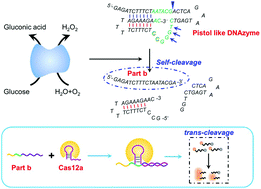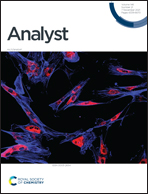Ultrasensitive glucose detection from tears and saliva through integrating a glucose oxidase-coupled DNAzyme and CRISPR–Cas12a †
Abstract
The accurate and sensitive detection of glucose from secretory clinical samples, such as tears and saliva, remains a great challenge. In this research, a novel ultrasensitive glucose detection method consisting of a glucose oxidase (GOx), pistol-like DNAzyme (PLDz), and CRISPR–Cas12a system is proposed. First, the oxidation of glucose catalyzed by GOx leads to the production of H2O2; the self-cleavage activity of PLDz is activated after recognition of the produced H2O2. The two procedures triggered by COx and PLDz play an important role in accurately identifying glucose and converting glucose signals to nucleic acids. The obtained PLDz fragments can be recognized by the Cas12 enzyme and thus activate the trans-cleavage activity of the Cas12a enzyme. Finally, the surrounding reporter probes are cut by the Cas12a enzyme to produce fluorescence signals. In summary, an ultra-sensitive and specific fluorescence method has been developed for glucose detection from secretory clinical samples, which could potentially contribute to the noninvasive diagnosis of diabetes mellitus.



 Please wait while we load your content...
Please wait while we load your content...